As the world becomes more automated, smart devices have started to take over pool maintenance.
Pool testing is the most important part of ensuring your water is clean and clear of any contaminants. Your testing device should be accurate, reliable, and be able to provide all the necessary testing parameters.
The Sutro Pool Monitor has nailed almost all of those criteria.
Disclosure: This product was provided to me by Sutro. I have not been compensated for this review. All opinions expressed are my own. This post contains affiliate links.
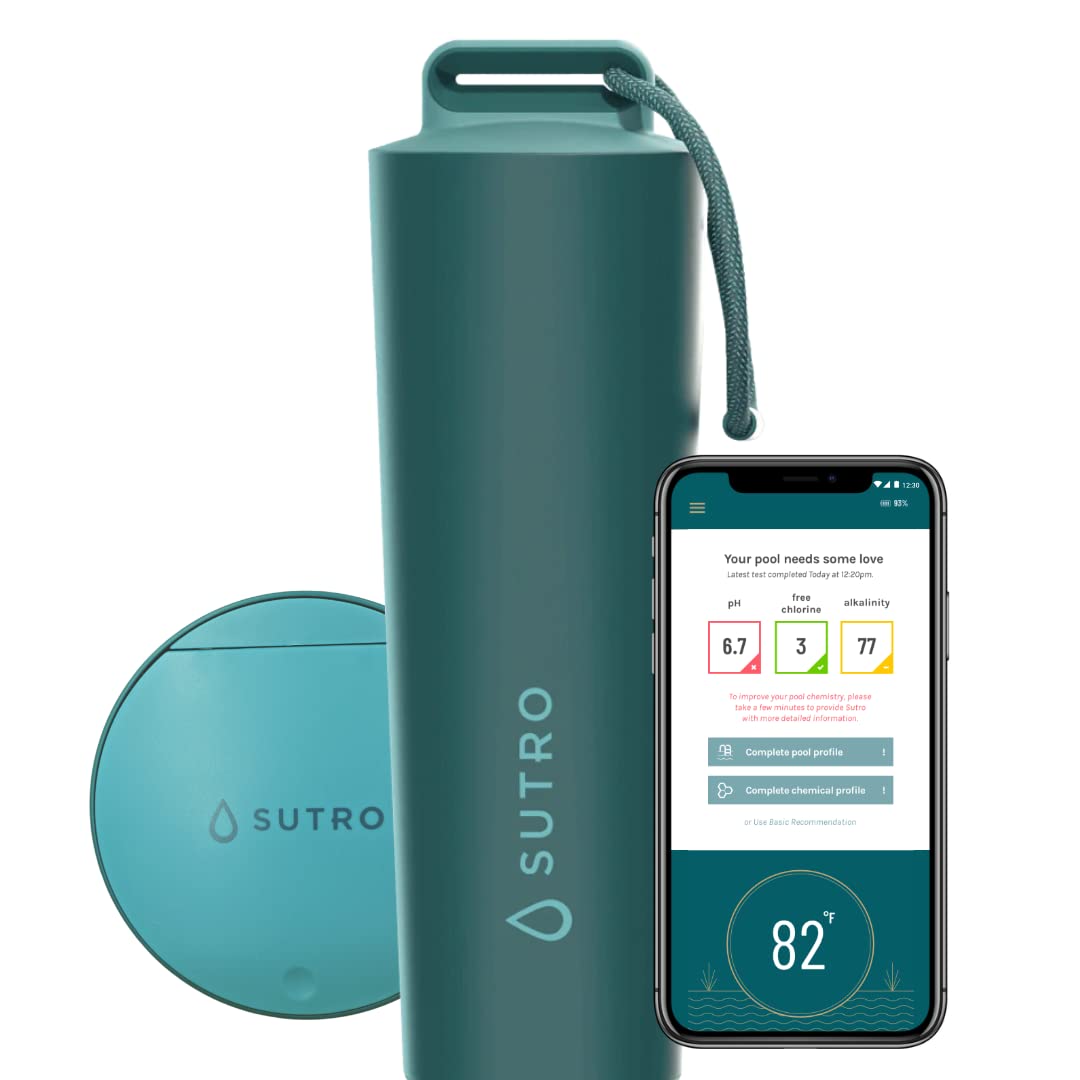
Sutro Water Monitoring System
The Sutro Pool Monitor gives accurate results for the parameters it tests, but unfortunately, it won’t provide a full picture of the overall pool chemistry.
Pros
Cons
Use code TESTYOUROWNPOOL at checkout for $50 off your purchase.
*By buying from these links, I may earn from qualifying purchases at no additional cost to you.
Sutro Pool Monitor Overview
The Sutro Water Monitoring System is self-described as a “water testing robot that floats in your pool (or spa).”
It tests for pH, total alkalinity (TA), and free chlorine (FC) or bromine. It also provides a water temperature reading. The pH and free chlorine are tested 3 times a day, TA is tested once per day, and temperature is tested hourly.
In terms of the parameters, how each are tested:
- pH uses phenol red, the same reagent in most liquid-based testing kits. Its testing range is from 6.8 – 8.2 (+/- 0.2)
- Free chlorine is measured with DPD (see the differences in chlorine tests). Testings range from 0 – 5 ppm (+/- 0.2 ppm if between 0 – 2.8, and +/- 0.7 ppm if between 2.9 – 5.0). Like all DPD testing, it becomes unreliable when chlorine measures 10 ppm and above.
- Total alkalinity uses a “proprietary” titration method, with a testing range from 40 – 200 ppm (+/- 20 ppm)
The monitor uses a cartridge containing reagents from LaMotte and Taylor Technologies. It uses drop-based reagent testing, which is far more accurate than other smart testing devices that use ORP (Oxidation-Reduction Potential) measurements.
The cartridge has 90 tests available, making it last roughly a month.
Readings are recorded and stored in the user-friendly Sutro app, giving you the ability to check your past readings to notice any specific trends your water tends to have.
As of August 2024, the device retails for $499, with a two-year warranty for $49 and a three-year warranty for $79.
Lastly, a subscription is required to use your Sutro device. There are two subscription packages:
- Basic: $29 / month
- Premium: $39 / month
Unboxing and Installation
The first thing you will notice when opening your Sutro box is just how big the device is. To be fair here, their site does mention that it is roughly the size of a forearm, which is pretty accurate.
The box itself is very sleek and modern. You can tell that Sutro puts a lot of time and effort into its design and user experience just from the box and inside.
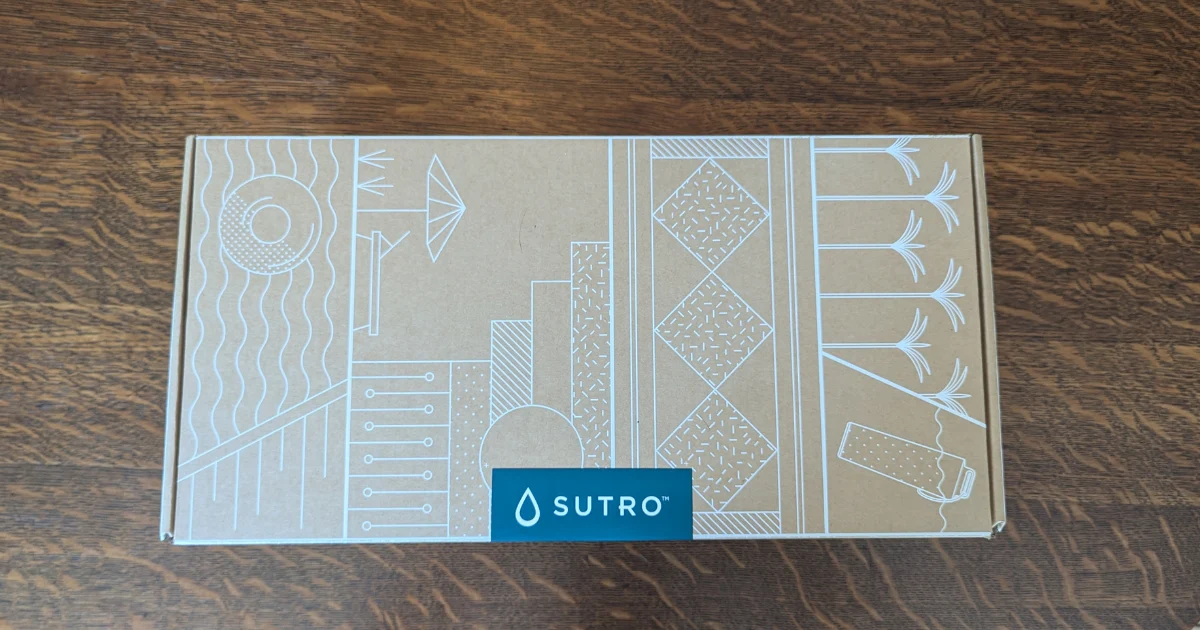
Inside the box, in addition to the device itself, it comes with the instruction manual, two interchangeable batteries, a hub and power adapter, and a test cartridge.
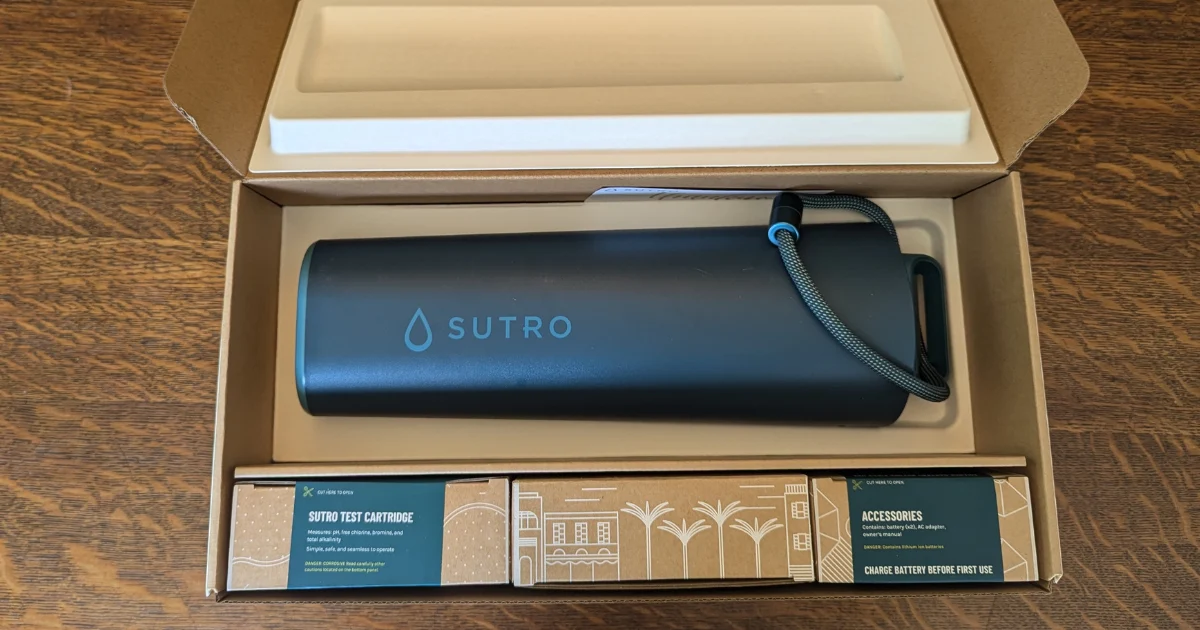
The installation and getting started was very easy with simple step-by-step instructions. After creating your profile in the app (including pool or spa information like the type of chemicals used, equipment used, gallons it holds, etc), it will guide you through the rest of the process.
The challenging part for me was finding a good spot for the hub. Sutro recommends the hub to be inside and within “50 feet line of sight” from the pool. Mine is a bit beyond that due to how far my pool is away from the house, but I have had no issues to date.
The only other decision you’ll need to decide is where to put it in the water. The device comes with a tether to attach to the side of the pool which is what I did. It’s much easier to maintain and I wanted the device to measure water from the same spot to get the most accurate readings.
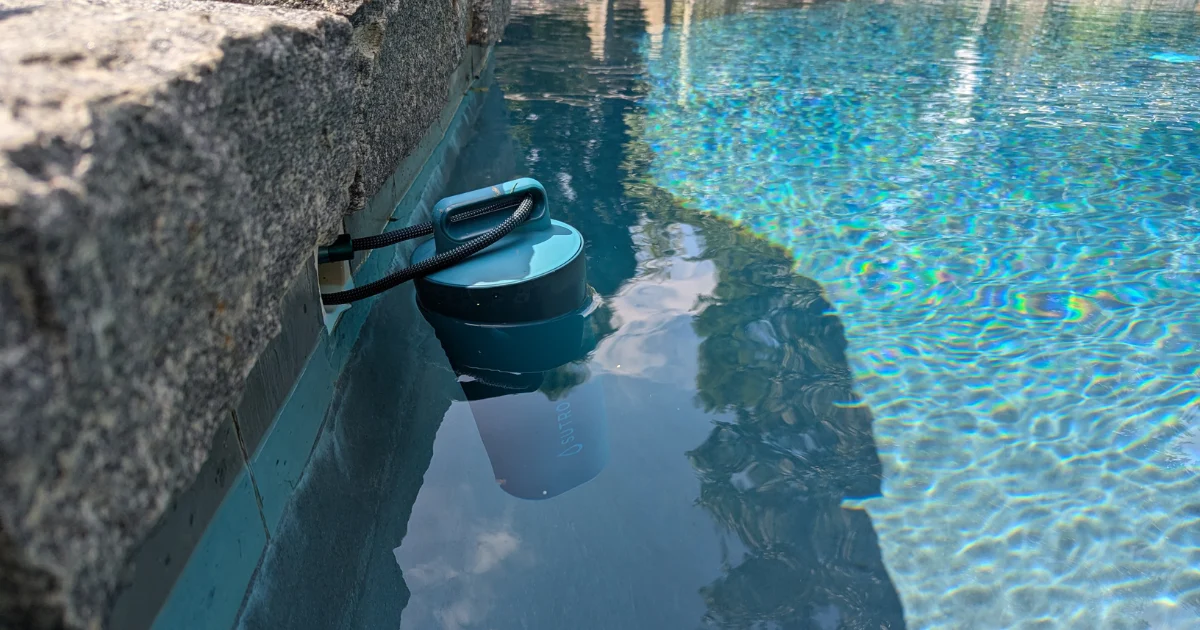
Once the monitor is set up, calibrated, and in the pool, it’s pretty much hands-off until you need to replace the cartridge and battery.
The Sutro App
I really like the Sutro app. From the design to the UI and UX, it is very user-centric and easy to use. The measured chemicals are big and bold, and it will show you what they perceive as chemical imbalances. (more on that later!)
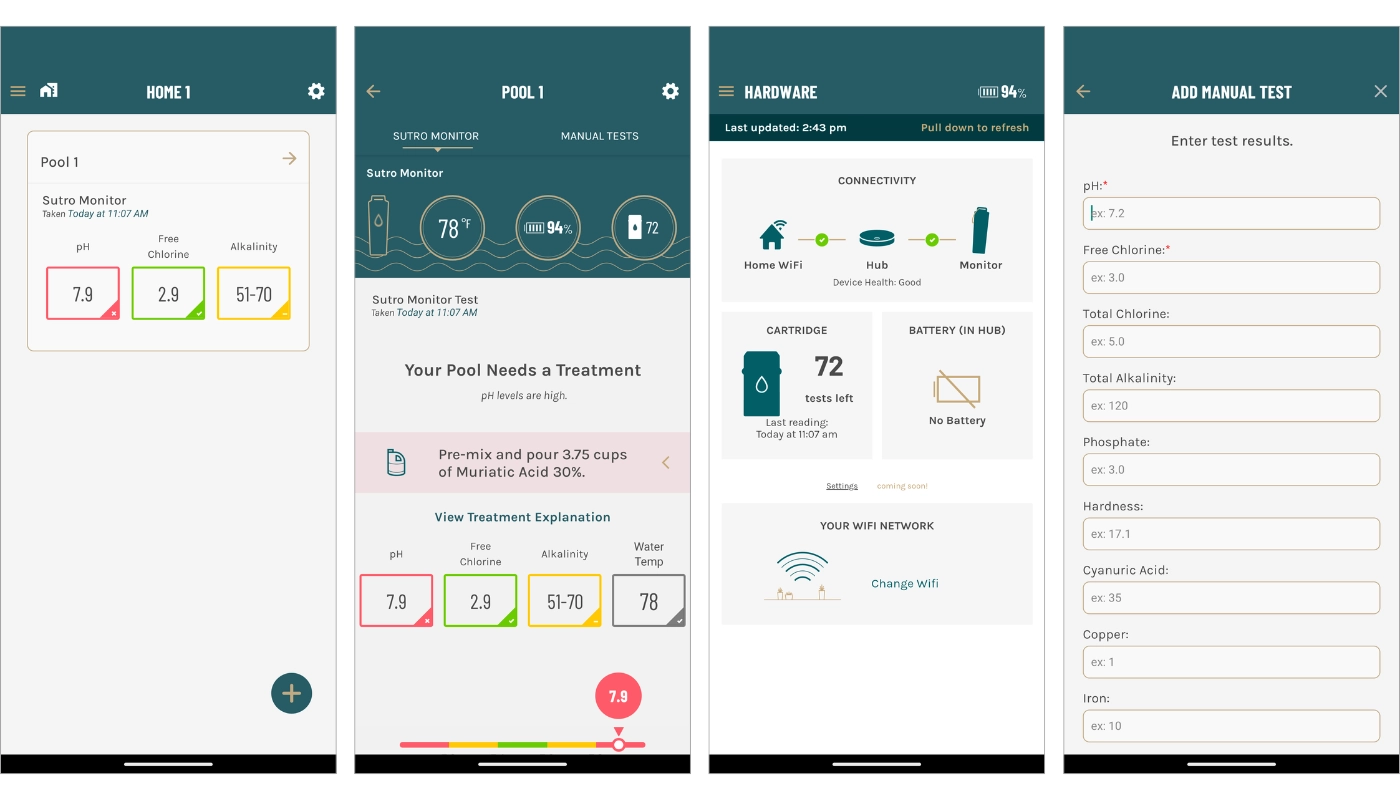
You can also set your pool’s current appearance and get recommendations on how to fix it. Issues like cloudy water, stains, and algae growth can be chosen.
Another cool feature they recently added is the ability to add readings from home test kits. This feature just came out as of this review (August 2024), but it should be easier to check and compare readings from another test kit.
One thing you cannot do on the app is manage your billing or account information. That can still only be done on the website. It’s a bit annoying switching between the two when looking at your membership information.
Updating Your “Pool Status” to Pause Subscription
Sutro makes it really easy to pause your subscription when closing the pool for the winter. I had no issues and it took me less than a minute.
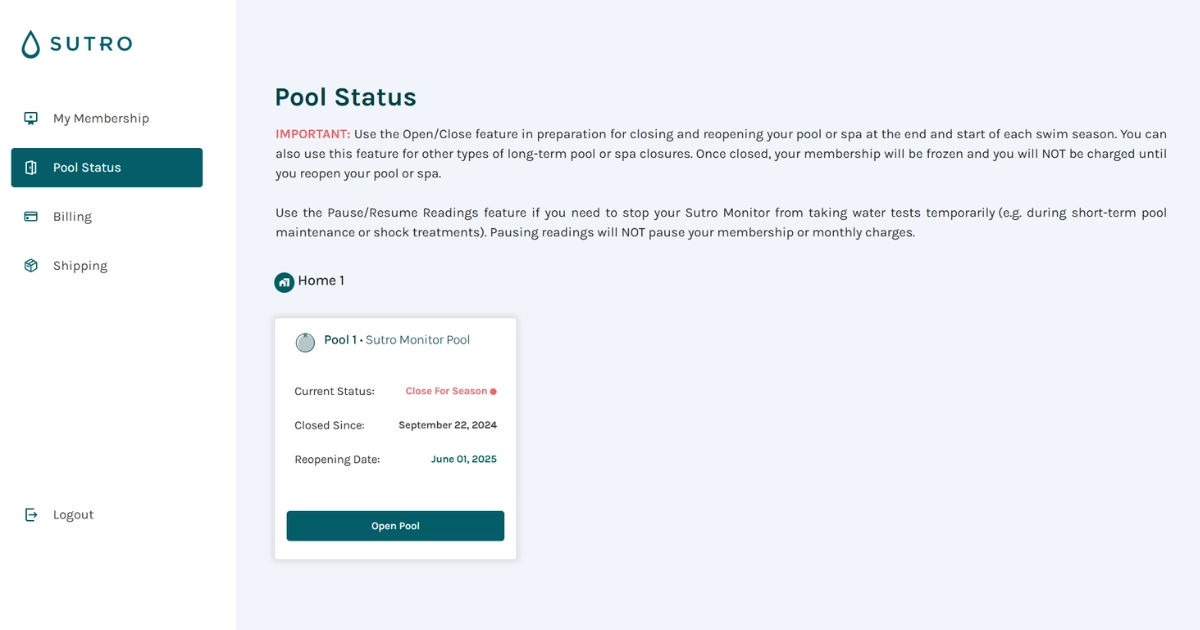
You are able to update your pool status on a temporary basis and for longer term offseasons.
Once you know when you are opening your pool, set the date and Sutro will automatically start your subscription back up send a new cartridge for the start of the season!
Performance of Sutro
As mentioned above, testing your pool is the most important aspect of maintenance. It is the only way to know if your water is not only clean and clear, but it has enough sanitizer to fight potential algae outbreaks.
Because of the importance, I want to be as critical as possible. Results of the Sutro device over the past couple of months have been compared with a Taylor K-2006 kit, the most accurate and reliable on the market.
Not All Chemistry Parameters Can Be Tested
Sutro only tests for free chlorine (FC), pH, and total alkalinity (TA). Right off the bat, the device will not give you an overall view of your water health.
It is missing readings for cyanuric acid (CYA), calcium hardness (CH), and combined chlorine (CC). This will require you to use a separate testing kit for these parameters.
However, with the exception of CCs, the device does test the parameters that are likely to change the most. For CYA and CH, numbers won’t change that much unless there are larger additions of fresh water, either from rainstorms or a drain and refill.
That does not mean they aren’t important, however. CYA dictates how much free chlorine needs to be in the water. It isn’t a one-size-fits-all solution so knowing your CYA ppm is necessary.
With the app allowing manual additions of testing, at least all your parameters can be read in one app.
Accuracy
I have actually been really impressed with the accuracy of the monitor. For the first couple of weeks with the device, I would still test daily or every other day to make sure I was still in range.
After that, however, I found myself not going out to test as much. For me, I consider this a pretty big deal.
Free chlorine and pH typically fell within their variances, with a few low-range readings mixed in.
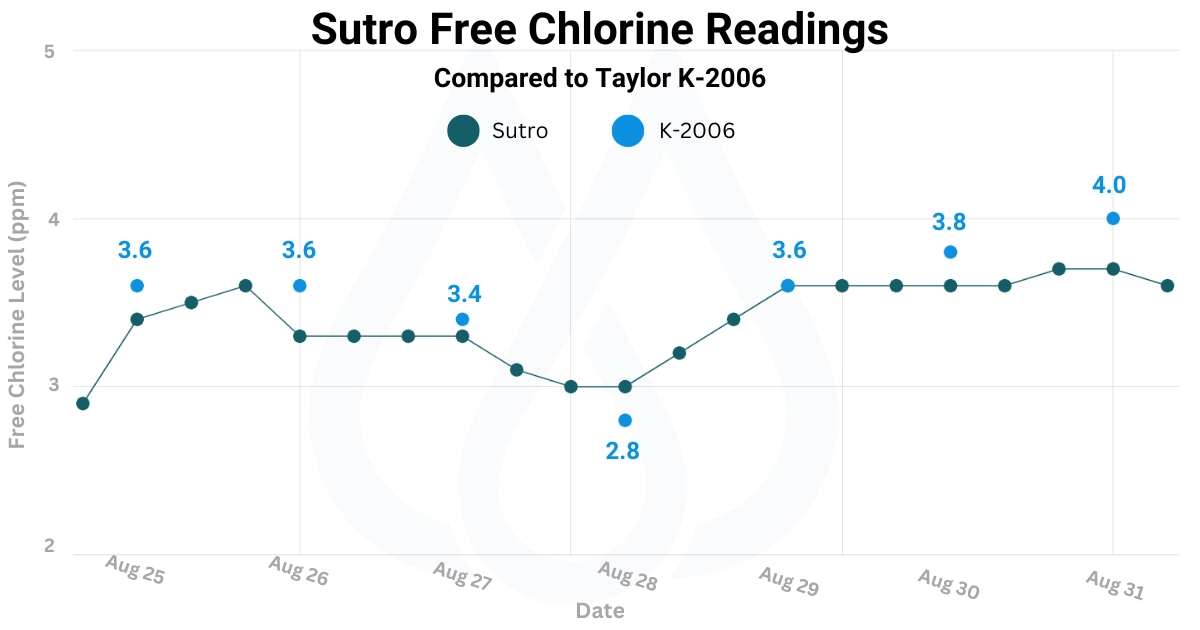
Total alkalinity can vary pretty wildly, particularly during the first couple days of a test cartridge change.
It wasn’t too much of an issue because I know my alkalinity levels rarely change during the season. However, this could be a potential problem for a newer pool owner or someone who is not as experienced with their pool.
Sutro Reliability
Knowing this is a smart device with a wifi connection and a hub, I’d expect some troubleshooting along the way.
However, except for human interference by unplugging the hub by mistake, there has been no downtime or missed readings.
It’s held up extremely well throughout the swim season. The only time I had to move the device from the water is for battery and cartridge changes.
Sutro’s Recommendations for Treatment and Ranges
- pH’s acceptable (green) range is 7.2 to 7.8. Treatment recommendations adjust pH to 7.5.
- Free chlorine’s acceptable range is 2 – 4 ppm. When measured below 2 ppm, Sutro will recommend raising it.
- Total alkalinity’s acceptable range is 80 – 120 ppm. Treatment recommendations adjust alkalinity to 100 ppm.
I appreciate Sutro trying to be a one-stop shop for chemical testing and treatment recommendations. They want to make it as easy as possible and it’s hard to knock them for it.
However, not every pool is the same. Currently, the app’s recommendations are only set to the parameters above with no ability to change them to my knowledge.
My pool, for example, likes to stay at a pH of 8.0 with an alkalinity of 50 – 60 ppm. That is where pH and alkalinity finds its balance for me. I will never be in Sutro’s accepted ranges.
It’s fine to have a default setting, but it would be great if you could adjust the accepted ranges based on your pool’s criteria.
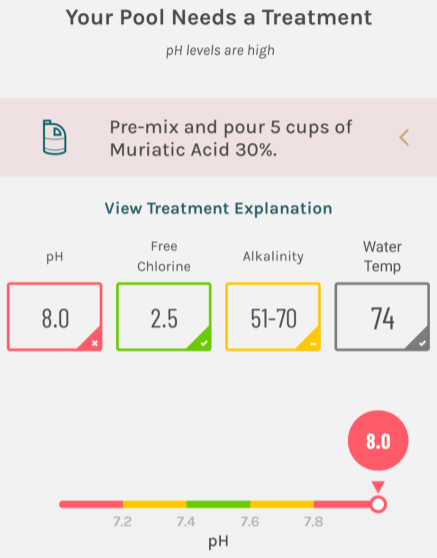
Second, having more content around the treatment explanations would serve their customers better. Sutro’s support and FAQ section has great recommendations and explainers.
For example, handling muriatic acid can be dangerous, and gloves and a mask should be worn when pouring it into the pool.
Nitpicky? Sure! But this can help those pool owners who might be new to day-to-day maintenance.
Verdict: Is it Worth The Price?
I’ll be honest: a $499 price tag with a minimum of a $29 monthly subscription gives me pause.
Considering there are test kits that will measure all necessary parameters at a fraction of the cost (with no subscription!), it can be hard to justify paying that much. Not to mention the fact you will need another testing method to measure CYA, calcium hardness, and combined chlorine.
I did find myself trusting the device more over time to the point that I was only using my K-2006 kit once a week for sanity checks. To me, that is a win.
I am all for making testing and pool maintenance easier, and Sutro certainly can play a role in that. It saved me time doing daily chlorine checks.
I can’t recommend using it as a primary testing device for the simple fact that it needs to be supplemented with another kit.
However, for the tests it does provide, it gives accurate and reliable readings. That is all you can ask for. I will certainly be using it moving forward.
